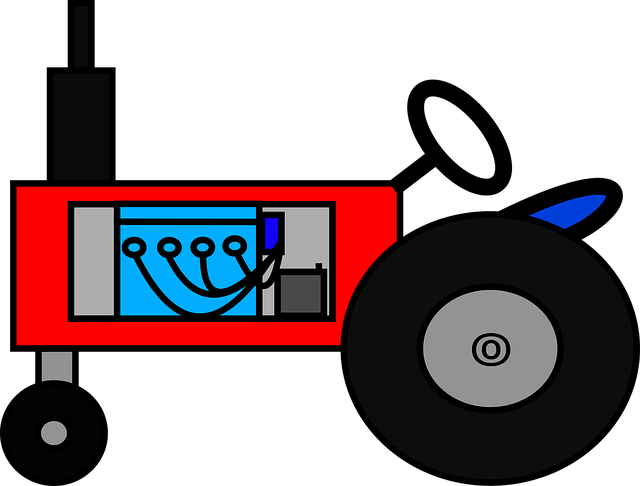Maintaining a lawn tractor battery is essential for its performance and longevity. These batteries typically use lead-acid or sealed lead-acid technology and should be monitored for optimal charge levels to prevent issues like low charge, which can necessitate battery replacement. Regular checks for clean and corrosion-free terminals, adequate water levels in traditional lead-acid batteries, and moderate storage conditions protect against extreme temperatures that can damage batteries. A comprehensive visual inspection of the battery and its connections, including secure mounting hardware and clean terminals, is crucial. For accurate voltage and charge assessment, use a digital multimeter or a specialized 12-volt battery tester, ensuring terminals are clean before testing. Regular load testing under the engine's operation can detect problems early, while addressing terminal corrosion with baking soda and dielectric grease helps maintain performance and extend battery life. If encountering starting difficulties, check the battery's electrolyte level, voltage reading, and condition for signs of distress or discharge. Following the owner's manual for specific advice ensures that your lawn tractor battery remains reliable and functional for all yard work needs. Regular upkeep and understanding the charging system's role are key to preventing unexpected failures and ensuring consistent performance from your lawn tractor.
When a lawn tractor falters, often the culprit is a weak battery. Ensuring your tractor’s battery is in top condition is key to a smoothly operating yard machine. This article demystifies the process of diagnosing and addressing a weak lawn tractor battery. From grasping the fundamentals of battery functionality to performing a thorough visual inspection, testing voltage and charge levels, detecting corrosion on terminals, and pinpointing electrical issues in the circuit, this guide equips you with the knowledge and steps needed to maintain your battery’s performance. Learn how to evaluate and act upon signs that it’s time for replacement or servicing of your lawn tractor battery, ensuring uninterrupted work on your garden and lawn maintenance tasks.
- Understanding Lawn Tractor Battery Functionality
- Visual Inspection of the Lawn Tractor Battery Components
- How to Test the Voltage and Charge Level of Your Lawn Tractor Battery
- Checking for Corrosion on Lawn Tractor Battery Terminals
- Diagnosing Electrical Issues in the Lawn Tractor Battery Circuit
- When to Replace or Service Your Lawn Tractor Battery: A Step-by-Step Guide
Understanding Lawn Tractor Battery Functionality

Lawn tractors are equipped with batteries that play a critical role in powering the electrical systems and starting the engine. Understanding how a lawn tractor battery functions is essential for maintaining its health and ensuring its longevity. These batteries, typically lead-acid or sealed lead-acid types, store energy produced by solar panels during daylight hours. When you activate the tractor, this stored energy is released to power the headlights, electric blade engagement, and other electrical components, culminating in the ignition system’s ability to start the engine.
To keep your lawn tractor battery functioning optimally, it’s important to regularly check its charge level and ensure that the battery terminals are clean and free from corrosion. A low charge can be a sign of an underlying issue, such as a poor connection or a battery that has reached the end of its lifespan. Regular use and proper care can prevent many problems associated with weak batteries. Additionally, storing your tractor in a cool, dry place and avoiding extreme temperatures can protect the battery from premature wear and tear. By understanding the functionality of your lawn tractor battery and performing routine checks, you can effectively maintain its performance and avoid unexpected breakdowns when you need your tractor most. Regular maintenance includes checking the water level if you have a traditional lead-acid battery (topping off with distilled water as necessary) and inspecting the battery case for cracks or bloating, which can indicate overcharging or an internal short circuit. With this knowledge, you can proactively manage your lawn tractor’s battery health, ensuring that it functions reliably whenever you need to tackle yard work.
Visual Inspection of the Lawn Tractor Battery Components

When diagnosing a weak lawn tractor battery, a thorough visual inspection of its components is an essential step in troubleshooting. Begin by examining the battery casing for any signs of cracks or corrosion, as these can compromise the integrity and performance of the battery. Ensure the battery is securely fastened to the tractor and that the mounting hardware shows no signs of wear or damage. Next, inspect the battery terminals and cables. Look for any loose, rusted, or frayed connections, as poor electrical contact can significantly reduce battery efficiency. The terminals should appear clean and tightly attached to both the battery and the lawn tractor’s electrical system. Any corrosion on the terminals can be cleaned using a wire brush, and the connections should be tightened with a wrench. Additionally, check the electrolyte level in the cells; it should be at or above the indicator marking without overflowing. A low electrolyte level can indicate an internal loss of charge, which may necessitate recharging or replacement of the battery. Regular visual inspections of these components can help prevent complete failure and ensure your lawn tractor’s battery remains reliable and ready for use.
How to Test the Voltage and Charge Level of Your Lawn Tractor Battery

When diagnosing a weak lawn tractor battery, understanding its voltage and charge level is paramount for effective maintenance. To test the voltage, which indicates the battery’s capacity to hold a charge, you will need a digital multimeter (DMM) or a battery tester specifically designed for 12-volt systems, like those commonly found in lawn tractors. Begin by cleaning the terminals and ensuring a secure connection between the tester and the battery to avoid false readings. Then, set the DMM to the voltage setting and connect it to the battery. Typically, a fully charged lawn tractor battery should read between 12.4 and 12.7 volts when measured under load. If your reading is below this range, the battery may require charging. For a more comprehensive assessment of the charge level, perform a load test by disconnecting the battery from the tractor, reattaching the DMM leads, and then cranking the lawn tractor’s engine for a few seconds. This simulates the demand on the battery while mowing, allowing you to observe its performance under stress. A healthy battery should maintain or slightly drop its voltage but recover within a short period after the load is removed. If the battery fails to hold a charge or does not rebound quickly, it may be time to replace it. Regular testing can prevent unexpected failures and ensure your lawn tractor operates efficiently.
Checking for Corrosion on Lawn Tractor Battery Terminals

When diagnosing a weak lawn tractor battery, inspecting the terminals for corrosion is a critical step. Corrosion on battery terminals can lead to poor electrical connections, which may cause your lawn tractor to crank slowly or not at all. Over time, the chemical reactions between the battery’s electrolyte and the metal components of the battery terminal can result in a white, powdery substance. This corrosion needs to be cleaned to maintain proper conduction. To address this issue, start by carefully cleaning the corroded terminals with a wire brush to remove as much of the corrosive material as possible without damaging the cables. After brushing, prepare a mixture of baking soda and water to create a paste, which you’ll then apply to the terminals. Gently scrub the terminals with this paste, rinse thoroughly with clean water, and dry them completely. Applying a coat of dielectric grease after cleaning can help prevent future corrosion and ensure a secure electrical connection. Regularly checking and maintaining the lawn tractor battery terminals is essential for the longevity and performance of your lawn tractor’s power source. Keeping the connections clean and free from corrosion not only extends the life of your battery but also ensures that your lawn tractor operates efficiently when you need it most.
Diagnosing Electrical Issues in the Lawn Tractor Battery Circuit

When diagnosing electrical issues in a lawn tractor’s battery circuit, it’s crucial to systematically check each component for proper function. A weak battery can lead to starting difficulties or failure, and pinpointing the problem often requires a step-by-step approach. Begin by inspecting the battery terminals and cables for signs of corrosion or looseness, as these issues can interrupt the electrical connection and cause a no-start situation. Clean any corroded terminals with a wire brush and battery terminal cleaner, then secure any loose connections to ensure a solid electrical link.
Next, use a multimeter to test the voltage of the battery when the tractor is off. A fully charged lawn tractor battery should read at least 12.4 volts. If the voltage is below this range, the battery may need recharging or replacement. Additionally, check the alternator or generator to ensure it’s properly charging the battery while the tractor is running. An alternator that’s not functioning correctly can lead to a consistently weak battery. Testing each component in the circuit, including the starter motor and solenoid, helps isolate the cause of the electrical malfunction. Identifying the specific issue, whether it’s a faulty battery, poor connections, or a charging system problem, is key to resolving the lawn tractor’s starting troubles and restoring its performance.
When to Replace or Service Your Lawn Tractor Battery: A Step-by-Step Guide

When your lawn tractor’s performance begins to wane, it might be time to assess and potentially replace or service your lawn tractor battery. A key indicator for battery replacement is difficulty starting the engine; if you notice that it’s taking more than normal turns of the key before the tractor responds, this could signal reduced battery capacity. Regular maintenance checks are crucial for extending the life of your lawn tractor battery. Begin by inspecting the battery terminals and cables for any signs of corrosion or looseness, as these can significantly impair battery function. Clean corroded terminals with a baking soda paste to ensure a good connection. Additionally, check the electrolyte level in the battery; if it’s low, distilled water may be required to top it off. Pay attention to the battery voltage using a multimeter. A fully charged battery should read around 12.6 volts; anything below 12.4 volts while the engine is off indicates that it’s time to recharge or replace the battery. If your lawn tractor has been sitting unused for an extended period, its battery may discharge, so it’s wise to keep it on a maintenance charge or remove it and store it properly to prevent this. Regular engagement with your lawn tractor’s battery through routine use or periodic charging can also help maintain its health. When in doubt, consulting the owner’s manual for specific recommendations on your model’s battery is advisable. By following these steps, you can effectively determine whether your lawn tractor battery requires replacement or simply a service to restore its performance and reliability.
When faced with a lawn tractor battery that’s not performing as it should, a systematic approach to diagnosis is key. By understanding the essential role of your lawn tractor battery and regularly inspecting its components, you can efficiently identify issues such as voltage and charge levels, corrosion on terminals, and electrical circuit problems. Following the guidelines outlined in this article for testing and maintenance will help you make informed decisions about when it’s time to replace or service your lawn tractor battery. Regular upkeep not only ensures your tractor operates at peak efficiency but also extends the life of your battery, saving you time and money in the long run. With these practices under your belt, maintaining a reliable power source for your lawn tractor becomes straightforward and manageable.



